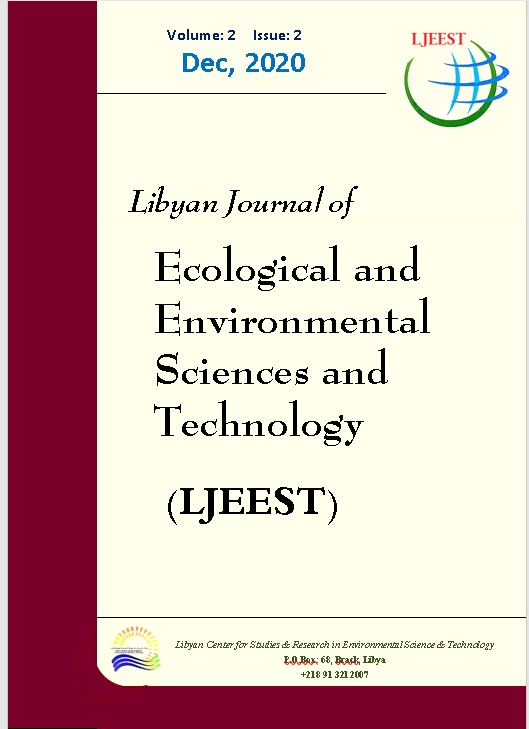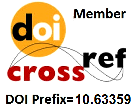Screening and Characterization of Marine Actinomycetes Isolated from Al-Khoms Shoreline
DOI:
https://doi.org/10.63359/46769y18Keywords:
Antimicrobial, Inhibition zone, Marine actinomycetes, Sediment, Secondary metabolitesAbstract
The detection of new antibiotics and other bioactive microbial metabolites is a benefit step given the rate of the rising multi-drug resistant pathogenic microorganisms. This study aimed to isolate and screen the antimicrobial activity of gram positive bacteria named actinomycetes. The actinomycetes were isolated from near-shore marine sediment that were collected from three different depths at the Libyan Alkhoms coastline. A total of five out of twenty actinomycetes were isolated on different supported medium, whereas, Sabouraud Dextrose Agar was found to exhibit the antagonistic properties of the bioactive compounds produced by actinomycetes isolates. These isolates had shown a clear zone on Mueller-Hinton agar against target microorganisms were considered as actinomycetes labelled from HSEH1 to HSEH20. The antimicrobial properties of these isolates against (Klebcella pneumonia, Escherichia coli, Salmonella typhi, Staphylococcus aureus and Candida albicance were examined by primary screening using spot inoculating method. were examined by primary screening using spot inoculating method. The results that all the five selected isolates were according to biochemical testes found to show inhibitory activity against the target microbes. Generally, HSEH16 isolate showed the highest inhibitory activity against all target pathogenic microbes compared with other selected isolates which have activity however, with different ranges of inhibition zone. Thus, the isolate HESH16 is the best among the other isolates considered to have a broad bacterial spectrum in this study. This isolate could be considered as potential antimicrobial properties of secondary metabolites against strains human pathogens and should be further studied for their human health.
References
Abo-Shadi M., Sidkey N.M., and Al-Mutrafy A.M. (2010). Antimicrobial agent producing microbes from some soils rhizosphere. Journal of American Science. 6(10), 915–925.
AitBarka E., Vatsa P., Sanchez L., Gaveau-Vaillant N., Jacquard C., Klenk H-P., Clément C., Ouhdouch Y., and Van Wezel G.P. (2016). Taxonomy, physiology, and natural products of Actinobacteria. Microbiology and molecular biology reviews. 80:1- 43.
Berdy J. (2005). Bioactive microbial metabolites. Journal of Antibiotic. 58: 1-26.
Berdy J. (2012). Thoughts and Facts About Antibiotics: Where We Are Now And Where We Are Heading. Journal of Antibiotics. 65: 385-395.
Bergeys manual of determinative bacteriology, (2000). Actinomyceteles 9th edition.
Cayol J.L., Ollivier B., Alazard D., Amils R., Godfroy A., Piette F., and Prieur D (2015). The Extreme Conditions of Life on the Planet and Exobiology. Environmental Microbiology Fundamentals and Application Microbial Ecology pp. 353-394.
Ceylan O., Okmen G., and Ugar A. (2008). Isolation of soil Streptomyces as source of antibiotics active against antibiotic-resistant bacteria, Eurasian Journal of BioSciences. 2:73-82.
Demain A. L., and Sanchez S. (2009). Microbial drug discovery: 80 years of progress, Journal of Antibiotic. 62:5-16.
Derosa S., Mitova M. and Tommonero G. (2003). Marine bacteria associated with sponges as a sources of cyclic peptides. Biomolecular Engineering 20: 311-316.
Dopazo C.P., Lemos M.L., Lodeiros C., Bolinches J., Barja J. and Toranzo A. E. (1988). Inhibitory activity of antibiotic producing marine bacteria against fish pathogens. Journal of Applied Bacteriology 65: 97-101.
Harwani D. (2013). Biodiversity of Rare Thermophilic Actinomycetes Inthegreat Indian Thar Desert: An overview in doam. Journal of Pharmaceutical Research. 3: 934-939.
Hayakawa M., Ishiwwa K., and Nonomurha H. (2004). Distribution of rare actinomycetes in Japanese soils. Journal of Fermentation and Bioengineering. 66:367–373
Hong, S., Ryu, H. W., Kim, J. & Cho, K. S. 2011. Rhizoremediation of diesel contaminated soil using the plant growth promoting rhizobacterium Gordonia sp. S2RP-17. Biodegradation 22:593-601.
Lee D. W., Lee J. M., Seo J. P., Schumann P., Kim S.J. and Lee S.D. (2010). Phycicolagilvus gen. Nov., an actinobacterium isolated from living seaweed. International Journal of Systematic and Evolutionary Microbiology. 58:1318-1323.
Lemos M. L., Toranzo A. E. and Barja J. L. (1985). Antibiotic activity of epiphytic bacteria isolated from intertidal seaweeds. Microbial Ecology.11:149-163.
Marit H. S., Kjell D. J., Geir K. A., Svein V., Trond E.E. and Per B. (2010). Isolation and characterization of marine pigmented bacteria from Norwegian Coastal waters and screening for carotenoids with UVA-Blue light absorbing properties. The Journal of Microbiology 48(1):16-23.
Matsumoto D., Takeuchi S., Andayani S., Kouznetsova N., and Krupp D. (1998). The contribution of Individualism-collectivism to cross-national differences in display rules. Asian Journal of Social Psychology. 1:147-165.
McCarthy S. A., Johnson R. M. and Kakimoto D. (1994). Characterization of an antibiotic produced by Alteromonas luteoviolacea Gauthier 1982, 85 isolated from Kinko Bay, Japan. Journal of Applied Bacteriology 77: 426-432.
Miyadoh S. (1993). Research on antibiotic screening in Japan over the last decade: a producing microorganisms approach, Actinomycetol. 7:100-106.
Mohammadipanah F. and Wink J. (2016). Actinobacteria from Arid and Desert Habitats: Diversity and Biological Activity. Frontiers in Microbiology 6:1541.
Oskay M., Tamer A.Ü. and Azeri C. 2004. Antibacterial activity of some actinomycetes isolated from farming soils of Turkey. African Journal of Biotechnology. 3: 441-446.
Pickup K.M., Nolan R.D. and Bushell M.E. (1993). A method for increasing the success rate of duplicating antibiotic activity in agar and liquid cultures of Streptomyces isolates in new antibiotic screens, Journal of Fermentation and Bioengineering. 76: 89-93.
Raytapadar S. and Paul A.K. ( 2001). Production of an antifungal antibiotic by Streptomyces aburaviensis (1DA-28), Microbiology Research. 155:315-323.
Richa S. and Vivek S. (2018). The Role of Actinobacteria in the Production of Industrial Enzymes. New and Future Developments in Microbial Biotechnology and Bioengineering pp. 165-177.
Saadoun I., Al-Joubori B. and Al-Khoury R. (2015). Testing of Production of Inhibitory Bioactive Compounds by Soil Streptomycetes as Preliminary Screening Programs In UAE For Anti-Cancer and Anti-Bacterial Drugs. international journal of current microbiology and applied sciences. 4(3):446-459.
Shantikumar L., Baruah I. and Bora T.C.(2006). Actinomycetes of loktak habitat:Isolation and Screening for Antimicrobial Activities.Biotechnology. 5:217-221.
Shomurat T., Yoshida J., Amano S., Kojina, M. and Niida T. (1979). Studies on actinomycetal producing antibiotics only in agar culture. I. Screening taxonomy and morphology productivity relationship of Streptomyces halstedii, strain SF. Journal of. Antibiotics, 32: 427-435.
Singh L.S., Baruah I. and Bora T.C. (2006). Actinomycetes of Loktak and Habitat: Isolation and screening for antimicrobial activities. Biotechnology. 5:217-221.
Tiwari K. and Gupta R.K. (2012). Rare Actinomycetes: A Potential Storehouse For
Downloads
Published
Issue
Section
License

This work is licensed under a Creative Commons Attribution-NonCommercial 4.0 International License.















